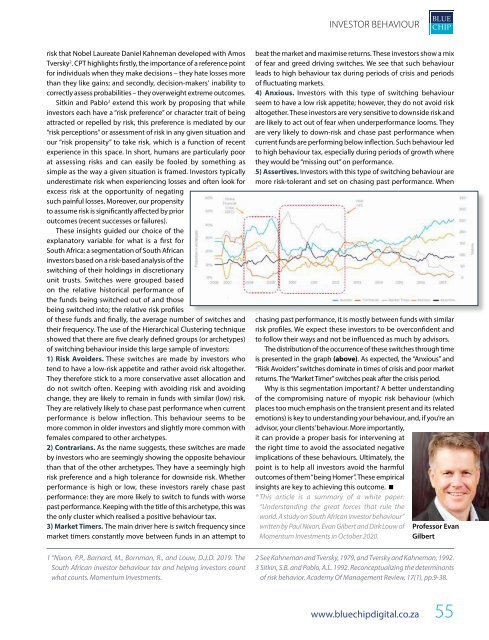Blue Chip Issue 78 - Jan 2021
Create successful ePaper yourself
Turn your PDF publications into a flip-book with our unique Google optimized e-Paper software.
INVESTOR BEHAVIOUR<br />
risk that Nobel Laureate Daniel Kahneman developed with Amos<br />
Tversky 2 . CPT highlights firstly, the importance of a reference point<br />
for individuals when they make decisions – they hate losses more<br />
than they like gains; and secondly, decision-makers’ inability to<br />
correctly assess probabilities – they overweight extreme outcomes.<br />
Sitkin and Pablo 3 extend this work by proposing that while<br />
investors each have a “risk preference” or character trait of being<br />
attracted or repelled by risk, this preference is mediated by our<br />
“risk perceptions” or assessment of risk in any given situation and<br />
our “risk propensity” to take risk, which is a function of recent<br />
experience in this space. In short, humans are particularly poor<br />
at assessing risks and can easily be fooled by something as<br />
simple as the way a given situation is framed. Investors typically<br />
underestimate risk when experiencing losses and often look for<br />
excess risk at the opportunity of negating<br />
such painful losses. Moreover, our propensity<br />
to assume risk is significantly affected by prior<br />
outcomes (recent successes or failures).<br />
These insights guided our choice of the<br />
explanatory variable for what is a first for<br />
South Africa: a segmentation of South African<br />
investors based on a risk-based analysis of the<br />
switching of their holdings in discretionary<br />
unit trusts. Switches were grouped based<br />
on the relative historical performance of<br />
the funds being switched out of and those<br />
being switched into; the relative risk profiles<br />
of these funds and finally, the average number of switches and<br />
their frequency. The use of the Hierarchical Clustering technique<br />
showed that there are five clearly defined groups (or archetypes)<br />
of switching behaviour inside this large sample of investors:<br />
1) Risk Avoiders. These switches are made by investors who<br />
tend to have a low-risk appetite and rather avoid risk altogether.<br />
They therefore stick to a more conservative asset allocation and<br />
do not switch often. Keeping with avoiding risk and avoiding<br />
change, they are likely to remain in funds with similar (low) risk.<br />
They are relatively likely to chase past performance when current<br />
performance is below inflection. This behaviour seems to be<br />
more common in older investors and slightly more common with<br />
females compared to other archetypes.<br />
2) Contrarians. As the name suggests, these switches are made<br />
by investors who are seemingly showing the opposite behaviour<br />
than that of the other archetypes. They have a seemingly high<br />
risk preference and a high tolerance for downside risk. Whether<br />
performance is high or low, these investors rarely chase past<br />
performance: they are more likely to switch to funds with worse<br />
past performance. Keeping with the title of this archetype, this was<br />
the only cluster which realised a positive behaviour tax.<br />
3) Market Timers. The main driver here is switch frequency since<br />
market timers constantly move between funds in an attempt to<br />
1 “Nixon, P.P., Barnard, M., Bornman, R., and Louw, D.J.D. 2019. The<br />
South African investor behaviour tax and helping investors count<br />
what counts. Momentum Investments.<br />
beat the market and maximise returns. These investors show a mix<br />
of fear and greed driving switches. We see that such behaviour<br />
leads to high behaviour tax during periods of crisis and periods<br />
of fluctuating markets.<br />
4) Anxious. Investors with this type of switching behaviour<br />
seem to have a low risk appetite; however, they do not avoid risk<br />
altogether. These investors are very sensitive to downside risk and<br />
are likely to act out of fear when underperformance looms. They<br />
are very likely to down-risk and chase past performance when<br />
current funds are performing below inflection. Such behaviour led<br />
to high behaviour tax, especially during periods of growth where<br />
they would be “missing out” on performance.<br />
5) Assertives. Investors with this type of switching behaviour are<br />
more risk-tolerant and set on chasing past performance. When<br />
chasing past performance, it is mostly between funds with similar<br />
risk profiles. We expect these investors to be overconfident and<br />
to follow their ways and not be influenced as much by advisors.<br />
The distribution of the occurrence of these switches through time<br />
is presented in the graph (above). As expected, the “Anxious” and<br />
“Risk Avoiders” switches dominate in times of crisis and poor market<br />
returns. The “Market Timer” switches peak after the crisis period.<br />
Why is this segmentation important? A better understanding<br />
of the compromising nature of myopic risk behaviour (which<br />
places too much emphasis on the transient present and its related<br />
emotions) is key to understanding your behaviour, and, if you’re an<br />
advisor, your clients’ behaviour. More importantly,<br />
it can provide a proper basis for intervening at<br />
the right time to avoid the associated negative<br />
implications of these behaviours. Ultimately, the<br />
point is to help all investors avoid the harmful<br />
outcomes of them “being Homer”. These empirical<br />
insights are key to achieving this outcome. <br />
* This article is a summary of a white paper:<br />
“Understanding the great forces that rule the<br />
world. A study on South African investor behaviour”<br />
written by Paul Nixon, Evan Gilbert and Dirk Louw of<br />
Momentum Investments in October 2020.<br />
Professor Evan<br />
Gilbert<br />
2 See Kahneman and Tversky, 1979, and Tversky and Kahneman, 1992.<br />
3 Sitkin, S.B. and Pablo, A.L. 1992. Reconceptualizing the determinants<br />
of risk behavior. Academy Of Management Review, 17(1), pp.9-38.<br />
www.bluechipdigital.co.za<br />
55


















